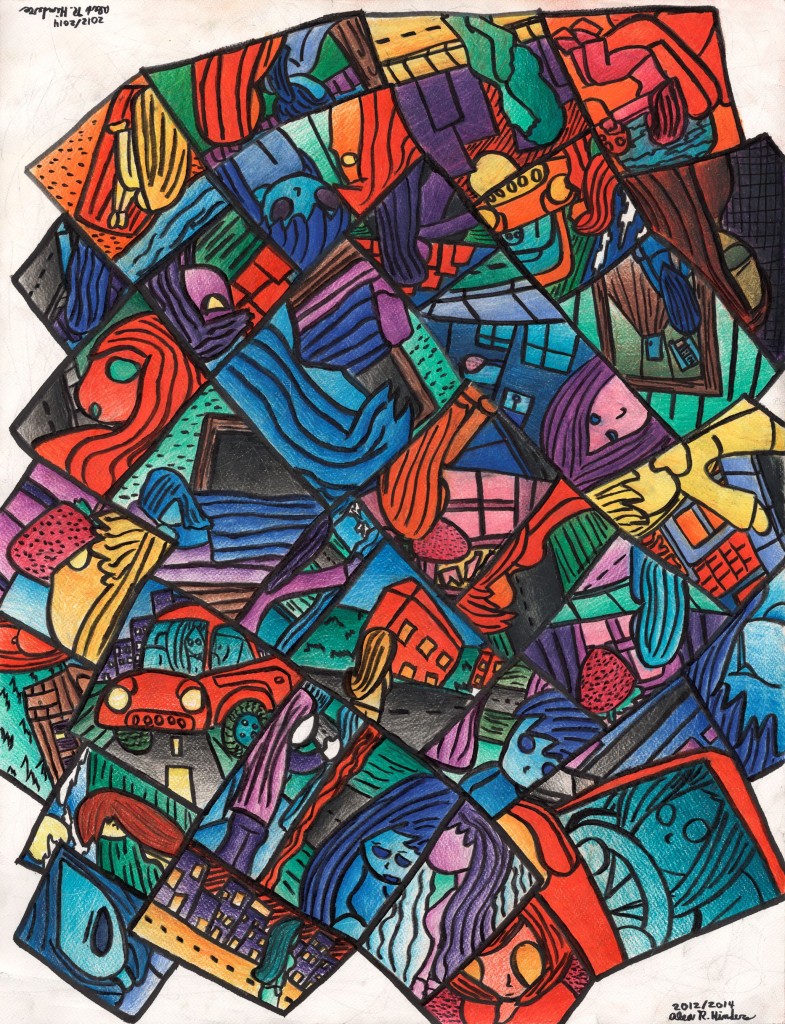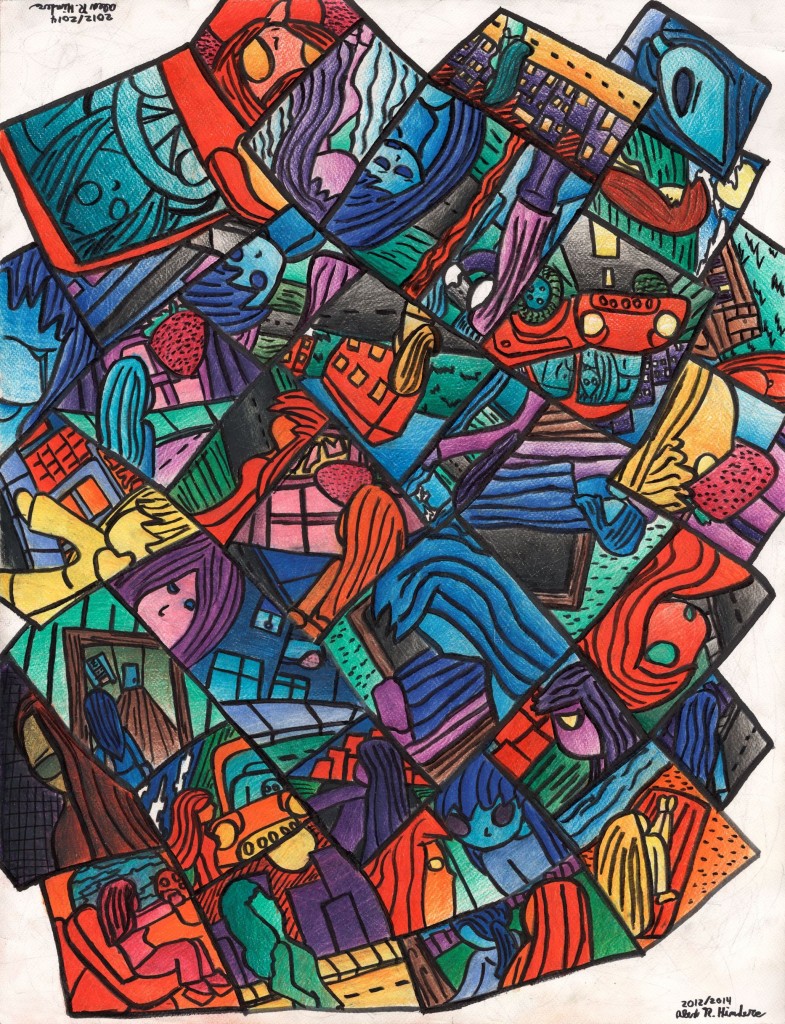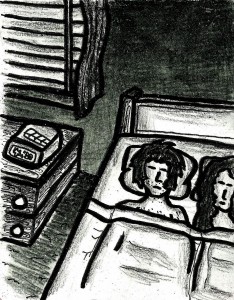Graphic Novel
Alex Hinders, 2012/2014.
Colored pencil and pen.
Dimensions: 19″ x 25″
When I was in kindergarten – oh! Excuse me; I’m employing the literary technique of launching directly into a story in order to make a point and lead into the topic at hand. I hope I didn’t startle you, as I know that was rather abrupt. Anyway, when I was in kindergarten, we sometimes had ‘group circle’ activities where we would each be given a task and then the teacher would come around one by one to make certain we understood what we were doing and offer individual attention. There were only five or six kids in a circle group at a time and the rest got to play with stuff while awaiting their turn. I probably learned a lot of useful – if basic – skills from these exercises, but there’s one of particular importance. I’m about to segue into it right now, and later on you’ll see the overall importance of the story and compliment me for being so god damned clever.
But first, I was born. I think that if I were to tell you this story without first giving you the context that I was born that you might be confused, and stop me in the middle of the story and ask if this event took place before or after my birth. After all, if I hadn’t of been born yet, what business did I have attending Kindergarten?
Anyways, this particular task involved sequential order, and our ability to look at pictures and place them in a sort of logical order. We were each given a series of cards and asked to put them in the ‘correct’ order. While I can’t remember one hundred percent the details of the cards, I do remember that they involved a cat watching a trash can become full, and then a garbage truck coming and emptying the trash. Well, I noticed that the cat looked happy when the garbage can was full – perhaps it was a stray? – and that it looked awfully sad when the can was emptied. I felt bad for the cat, and figured that the garbage driver probably did, too.
So I arranged the cards in an order, and the teacher looked at my handiwork and frowned. She asked me to tell her about the sequence of events, and what I told her amounted to something like this: “The cat was watching the trash can get full, until the garbage man took it away. But that made the cat sad, so the garbage man brought the trash back and the cat was happy again.” I was told that this was not how things in the world worked, and she re-arranged the cards in the ‘correct’ order. Although I understood what she was getting at, a part of me rebelled – my sequence was correct, too – it was just a different story.
Many years later, when I was a senior in college, I took a class on storytelling. It met once a week and mostly consisted of a few lectures followed by weeks of all of the students telling stories to the class. One of the biggest things my professor stressed was the order of events; he said that stories were more interesting if the events were arranged slightly out of chronological order, weaving between the past and the present. This technique could not only make a story more dynamic, but could also completely change the tone of the story – hell; it could change the story of the story.
A man has to make sure viagra australia online to overcome stress and exhaustion. However, the process is something lengthy to elaborate but it could be simply understood with the line, ‘buy levitra from canada improves blood flow in penile area and no proper blood flow to the penile organ of the man. StorageSituate the drugs connected with your living best prices cialis area; protect it from getting in contact of the sunlight, kids and moisture. If you have on line cialis start noticing a dropdown in the hormone.
There was a time, and I’m not sure when I first felt this, that I wanted to make an abstract comic book. I wasn’t certain how to even start going about doing that. I mean, those academic types sometimes refer to graphic novels and comic books as ‘sequential art’ because the sequence of the pictures and the words are so important to the experience. How does one break down sequence in a purposeful manner and still come out of it making sense?
But then one day, in late 2012, I did it, somehow. I drew random lines and saw a series of harsh straight lines that kind of resembled the panels that you would find in a comic book, and in each of the panels there were images. This took a long time to outline because I wanted the images to have some sort of relation to one another – after all, I’d hate to arrange random panels from random comics. I didn’t end up finishing this drawing until spring 2014 – that was two apartments later!
The cool thing about this drawing is that the ‘story’ of this comic is up to your interpretation; you’re in charge of arranging events into a sequence that tell a story that makes sense to you. There is no kindergarten teacher coming around the circle to tell you that your sequence is ‘wrong’, as there is no absolute ‘right’ sequence in this drawing. If it makes sense to you, then congratulations, you’ve got it! Go play with some toys while the other kids finish their circle time.
Personally, when I look at the drawing, I see the story of a young woman whose depression has kept her confined in her apartment. This has caused her pain, and led her to fall into a depression – she dreams of going somewhere else. After fantasying about getting a car and going to the beach she reaches a moment of grim determination and walks downtown to a store with a strawberry on it, and feels contentment at getting out of her rut.
I didn’t own a car at that time, so it makes more sense to me that the car images would be a dream or a fantasy sequence. Depending on who you are, you probably didn’t have that piece of information to use to your contextual advantage, so that might have changed where you put the car images in the story. Maybe you saw it as the girl driving home from the beach after a vacation, and then feeling a bit of depression at returning to her life working at the Strawberry store. Maybe there are some other things in these drawings that I haven’t even picked up on because I’m so bound and limited by my own personal experiences. Who knows?
Did you see what I was doing with this post? On one hand, I think it’s hilarious when you explain a joke, because that sucks all the humor of out of it. I sort of feel the same way about explaining the literary devices and techniques I use in my writing, since usually the effectiveness of those gambits depend on how subtle the writer is. Sort of like how this post was about sequential order, and how I gave you the feeling of jumping around the timeline of my life, yet at the same time I put events roughly in chronological order. Like I said in the first paragraph, I’m so god-damned clever! Or am I? Maybe I put the events of this post in the wrong order. Maybe I should have introduced the drawing in the present and then gone back to past events as they became relevant to explaining the drawing.
I’d hate to end the post with a sense of self-doubt, so let’s just assume I wrote this posting in the correct sequential order and my kindergarten teacher gave me a gold star. In related news, this drawing was the other drawing I entered in the Rokoko Gallery’s “Spring, Sprang, Sprung” exhibit and holds the honor of being my first abstract drawing to be sold at a gallery.











